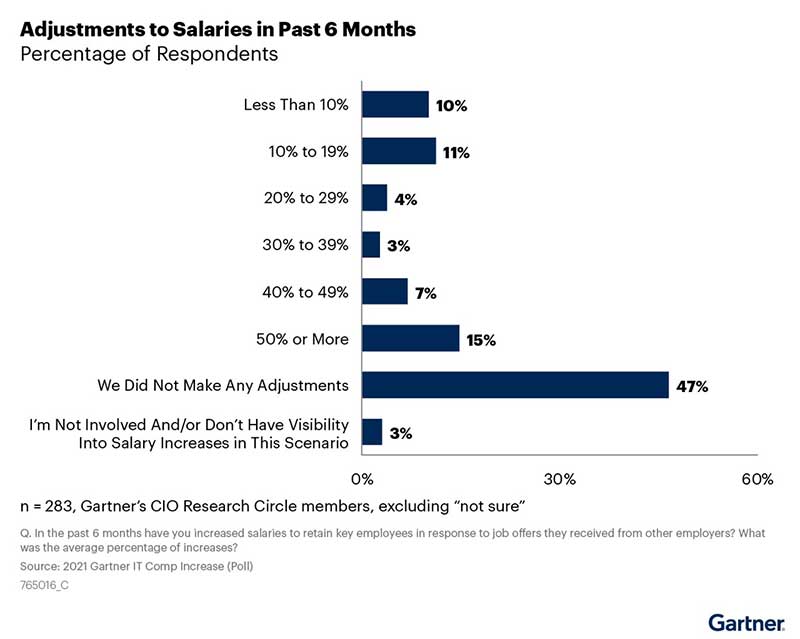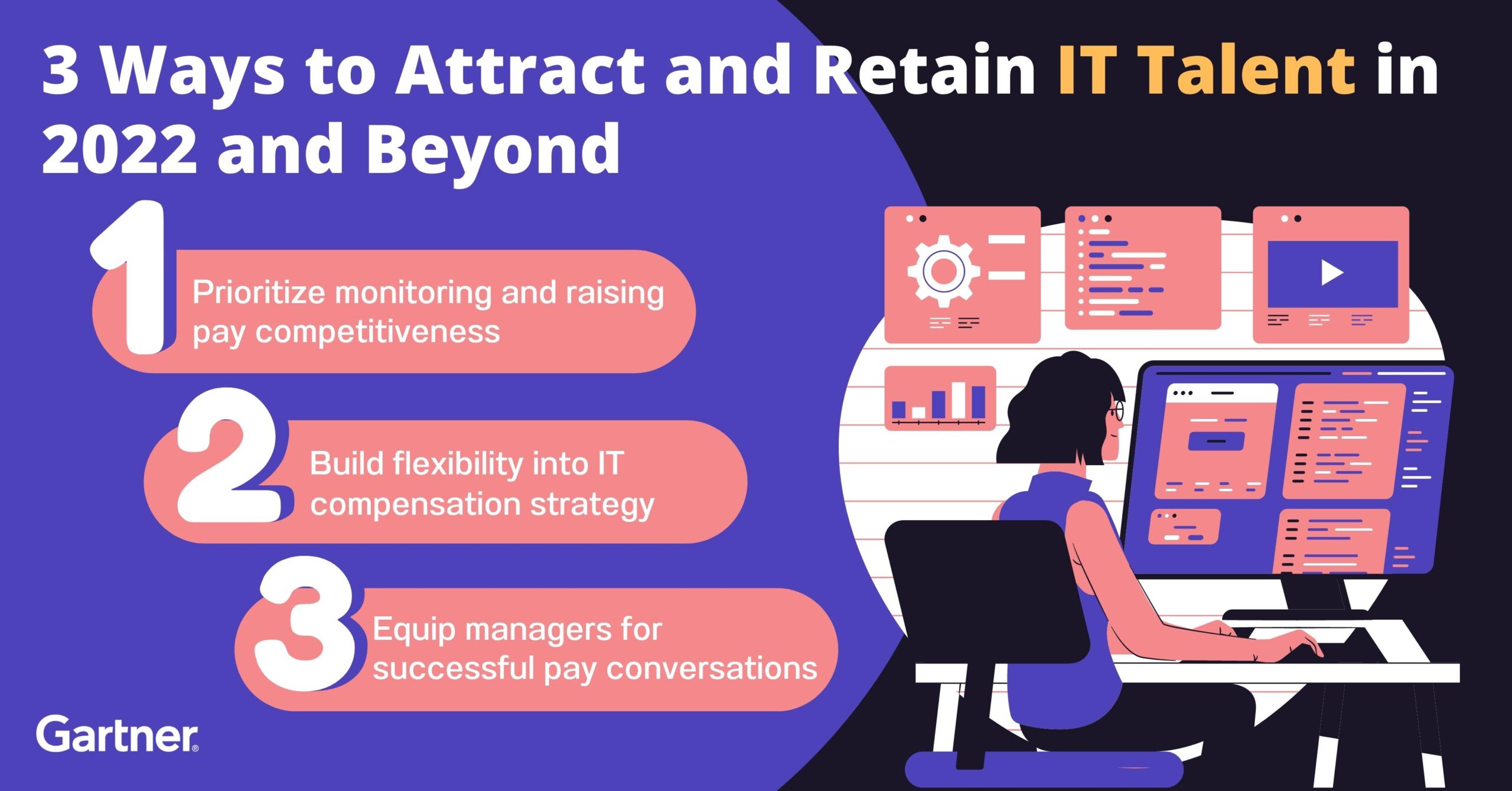Be strategic about compensation strategy to win IT talent.

By Lily Mok, Gartner VP Analyst
In short:
- Compensation is consistently ranked as both a top attraction and attrition driver by IT employees.
- In today’s competitive labor market, many in IT are now seeking new employment with better compensation packages and more flexibility.
- CIOs can effectively respond by making monitoring and raising pay competitiveness a priority, building flexibility into their IT compensation strategies and equipping individual managers for successful pay conversations.
In 2021 and 2022, the IT labor market has significantly tightened, making it very difficult to attract and retain talent. It’s no wonder that the Gartner Global Labor Market Survey consistently shows compensation is the No. 1 driver for IT talent attraction and retention.
While employees were once satisfied with their salaries and benefits, the pandemic — among other global events — has caused a shift, and many are now seeking new employment with better compensation packages and more flexibility. CIOs must decide how to address skills shortages and whether to offer higher compensation, perks and incentives, training and reskilling to increase retention.
Download now: The Roles and Skills to Prioritize in a Fiercely Competitive Labor Market
In the December 2021 Gartner IT Compensation Increase Poll, 50% of organizations reported increasing salaries to retain key employees in response to job offers those employees received from other employers. Making counteroffers and addressing nonfinancial factors important to IT talent retention have become key tactics.
Below, find three effective strategies to attract and retain IT talent in 2022 — and beyond.
No. 1: Prioritize monitoring and raising pay competitiveness
IT employees’ expectations are exceeding broad-based pay increases and what many CIOs feel is needed to retain staff and fill jobs.
In order to pinpoint where additional funding will be necessary to address pay gaps in the short term, work with your HR team to identify IT roles and skills areas facing higher attrition risk and recruitment challenges due to noncompetitive compensation.
Organizations with limited financial resources should prioritize allocating increases to those in roles in high-risk areas. In addition to the financial component, address additional human-deal factors that are important to IT talent retention.

No. 2: Build flexibility into IT compensation strategy
“Improving compensation competitiveness through paying high base salaries can be very costly, because this type of fixed cost is long-term,” says Lily Mok, Gartner VP Analyst. “Organizations very rarely reduce base pay once they raise it. One way to minimize locking in compensation adjustments as long-term fixed costs is to use variable pay components that can be adjusted or removed as talent needs and market conditions evolve.”
Common variable pay programs include:
- Skill-based premium pay, typically around 10% to 12.5% of base salary, is most often used to hire and retain IT talent with in-demand skills. Individuals must continue to perform well to receive it. An advantage of premium pay is that it can be flexed and adapted as business needs and market conditions evolve.
- A signing bonus is intended to incentivize a candidate to accept a job offer. A lump-sum payment upon hire is most common, but some organizations split this into one payment made upon hire and the remainder paid one year after hire.
- Retention bonuses can incentivize IT talent with critical skills to stay with their organization for a set period; for example, during a major digital transformation initiative. Specific criteria limit eligibility to a small percentage of the workforce, and awards can come in cash, stock or a combination of both.
No. 3: Equip managers for successful pay conversations
Partner with HR to communicate clearly what managers should expect in structured pay conversations. During periods of high turnover and in competitive labor markets, an effective pay communication strategy is a powerful tool to inform, engage and retain critical talent.
The core elements of an effective pay conversation are:
- Responding with empathy. Pay is a sensitive topic. Be empathetic in conversations around new information and work to help employees better understand and appreciate their compensation.
- Explaining the value of the rewards package. Detail both base compensation and the total value of an employee’s rewards package, including bonuses, benefits and well-being programs.
- Addressing public pay data. Be prepared to communicate the limitations of self-reported public pay data, and be transparent about the sources your organization uses to set pay. That way, you can properly answer questions about publicly reported compensation numbers.
ต้องมีกลยุทธ์กับ“การปรับค่าตอบแทน” เพื่อเอาชนะใจพนักงานไอที

โดย ลิลลี่ ม็อค รองประธานฝ่ายวิจัย การท์เนอร์ อิงค์
คำแนะนำแบบกระชับ
- สำหรับพนักงานในสายไอทีตลอดเวลาค่าตอบแทนเป็นทั้งสิ่งดึงดูดอันดับต้น ๆ และในขณะเดียวกันก็เป็นปัจจัยลดทอนประสิทธิภาพการทำงานของพนักงานไอที
- ในตลาดแรงงานที่มีการแข่งขันสูงในทุกวันนี้พบว่ามีบุคลากรไอทีจำนวนมากกำลังมองหางานใหม่ที่ให้ค่าตอบแทนดีกว่าและยืดหยุ่นกับการทำงานมากขึ้น
- ผู้บริหารไอที (CIOs) สามารถจัดการกับความคาดหวังนี้ได้อย่างมีประสิทธิภาพโดยให้ความสำคัญกับการตรวจสอบและการเพิ่มความสามารถในการแข่งขันด้านค่าจ้างเป็นอันดับแรก ๆ รวมทั้งการสร้างรูปแบบการทำงานที่มีความยืดหยุ่น ไปสู่กลยุทธ์ค่าตอบแทนด้านไอที (IT Compensation Strategies) รวมถึงให้อำนาจผู้จัดการแต่ละคนเพื่อให้เกิดความสำเร็จในการเจรจาต่อรองค่าตอบแทน
ปีที่แล้วและปีนี้ ตลาดแรงงานไอทีมีความเข้มข้นขึ้นอย่างเห็นได้ชัด ทำให้การสร้างแรงจูงใจและรักษาพนักงานที่มีทักษะความสามารถให้อยู่ทำงานต่อกับองค์กรเดิมเป็นเรื่องท้าทายอย่างมาก ซึ่งไม่ใช่เรื่องน่าแปลก เพราะจากการสำรวจตลาดแรงงานทั่วโลกของการ์ทเนอร์ล่าสุด (Gartner Global Labor Market Survey) เผยให้เห็นว่า “ค่าตอบแทน” ยังเป็นปัจจัยขับเคลื่อนสำคัญอันดับ 1 ที่จะสร้างแรงจูงใจและรักษาทีมงานไอทีระดับหัวกะทิให้อยู่กับองค์กร
บุคลากรไอทีอาจเคยพอใจกับฐานเงินเดือนและผลประโยชน์ที่ได้รับ แต่จากการระบาดใหญ่และสถานการณ์ต่าง ๆ ที่เกิดขึ้นทั่วโลกก่อให้เกิดการเปลี่ยนแปลง หลาย ๆ คนที่กำลังหางานใหม่ต้องการแพ็คเกจค่าตอบแทนและความยืดหยุ่นการทำงานเพิ่มมากขึ้น ซึ่งผู้บริหารไอทีต้องตัดสินใจว่าจะจัดการกับปัญหาการขาดแคลนทักษะด้านนี้อย่างไร และควรเสนอค่าตอบแทน ผลประโยชน์ สิ่งจูงใจอื่น ๆ ที่สูงกว่าเดิม หรือแม้กระทั่งการจัดฝึกอบรมและเพิ่มทักษะใหม่ ๆ เพื่อทำให้พวกเขาอยู่กับองค์กรต่อไป
ดาวน์โหลด: รายงาน The Roles and Skills to Prioritize in a Fiercely Competitive Labor Market
ในเดือนธันวาคม 2564 ข้อมูลจาก Gartner IT Compensation Increase Poll ระบุว่า 50% ขององค์กรรายงานว่าการเพิ่มเงินเดือนเพื่อรักษาบุคลากรสำคัญ ๆ ไว้เป็นการต่อสู้กับข้อเสนอที่พนักงานได้รับจากบริษัทอื่น ๆ โดยการให้ข้อเสนอใหม่ ๆ และการจัดการกับปัจจัยนอกเหนือจากเรื่องเงินเพียงอย่างเดียวนั้นได้กลายเป็นกลยุทธ์หลักที่มีความสำคัญต่อการรักษาพนักงานไอที
การ์ทเนอร์เสนอ 3 กลยุทธ์ในปีนี้และอนาคตที่ช่วยให้องค์กรธุรกิจมัดใจและรักษาบุคลากรไอทีที่มีฝีมือไว้ได้ ดังนี้
1: ให้ความสำคัญการตรวจสอบติดตามและเพิ่มความสามารถการแข่งขันเรื่องค่าตอบแทน
ความคาดหวังของบุคลากรไอทีมีมากกว่าเรื่องของการเพิ่มค่าจ้าง และซีไอโอจำนวนมากรู้สึกว่ามันจำเป็นเพื่อรักษาพนักงานและเติมเต็มช่องว่างการทำงาน
เพื่อระบุให้ได้ถึงแหล่งเงินเพิ่มเติมที่จะเป็นสิ่งจำเป็นในการแก้ปัญหาช่องว่างของค่าตอบแทนในระยะสั้น ผู้บริหารต้องทำงานร่วมกับฝ่ายบุคคลเพื่อระบุบทบาทและทักษะด้านไอทีที่กำลังเผชิญกับความเสี่ยงการขาดแคลนทักษะนั้น ๆ และความท้าทายในการสรรหาบุคลากรใหม่ ๆ อันเนื่องมาจากค่าตอบแทนที่จ่ายสู้รายอื่น ๆ ในตลาดไม่ได้
องค์กรที่มีข้อจำกัดด้านการเงินควรจัดลำดับความสำคัญเพื่อจัดสรรงบอย่างเหมาะสม โดยให้กับพนักงานที่มีบทบาทสำคัญและมีความเสี่ยงลาออก นอกเหนือจากองค์ประกอบทางการเงินแล้ว ควรระบุปัจจัยเพิ่มเติมเกี่ยวกับข้อตกลงระหว่างบุคคลซึ่งมีความสำคัญต่อการรักษาพนักงานไอทีคุณภาพไว้กับองค์กร
การปรับเงินเดือนช่วง 6 เดือนที่ผ่านมา (ตามเปอร์เซ็นต์ของผู้ตอบแบบสอบถาม)
 2: สร้างความยืดหยุ่นไว้ในกลยุทธ์ค่าตอบแทนไอที
2: สร้างความยืดหยุ่นไว้ในกลยุทธ์ค่าตอบแทนไอที
ลิลลี่ ม็อค รองประธานฝ่ายวิจัยของการท์เนอร์ กล่าวว่า “การปรับปรุงความสามารถในการแข่งขันด้านค่าตอบแทนด้วยการเพิ่มฐานเงินเดือนขึ้นเป็นต้นทุนที่สูงขององค์กร เนื่องจากเงินเดือนเป็นต้นทุนคงที่ระยะยาว ซึ่งองค์กรต่าง ๆ เมื่อมีการปรับฐานเงินเดือนเพิ่มแล้วจะไม่ค่อยลด มีวิธีหนึ่งเพื่อช่วยให้การมอบค่าตอบแทนไม่กลายเป็นต้นทุนคงที่ระยะยาวขององค์กร คือ การใช้กลยุทธ์การจ่ายค่าตอบแทนแบบแปรผันที่ปรับเปลี่ยนหรือตัดออกได้ตามความสามารถและตามการเปลี่ยนแปลงของตลาด”
ตัวอย่าง โปรแกรมจ่ายค่าตอบแทนแบบผันแปรทั่วไป ประกอบด้วย:
- การจ่ายค่าตอบแทนพิเศษตามทักษะ โดยทั่วไปจะอยู่ที่ประมาณ 10% ถึง 5% ของฐานเงินเดือน ส่วนใหญ่มักใช้เพื่อจ้างและรักษาพนักงานไอทีที่มีทักษะตามที่องค์กรต้องการ ซึ่งจะได้รับก็ต่อเมื่อตัดสินใจทำงานต่อไป ข้อดีของการจ่ายค่าตอบแทนพิเศษนี้ คือ สามารถยืดหยุ่นและปรับเปลี่ยนได้ตามความต้องการทางธุรกิจและสภาวะตลาดที่เปลี่ยนแปลงไปอยู่ตลอดเวลา
- เงินโบนัสเพิ่มเติมเพื่อจูงใจพนักงานเมื่อรับข้อเสนองาน เป็นการจ่ายเงินก้อนเพื่อจ้างเป็นกรณี ๆ ไป ซึ่งถือเป็นเรื่องปกติที่สุด แต่บางองค์กรเลือกจ่ายเงินตอบแทนครั้งเดียวตอนจ้างทำงานและจ่ายส่วนที่เหลือหนึ่งปีหลังจากการจ้างงาน
- เงินโบนัสเพื่อรักษาพนักงานไอทีที่มีทักษะสำคัญ ๆ ให้ทำงานต่อกับองค์กรในช่วงเวลาที่กำหนด ตัวอย่างเช่น ช่วงการริเริ่มโครงการดิจิทัลทรานฟอร์มเมชั่นครั้งใหญ่ มีการกำหนดเกณฑ์ทำงานเฉพาะที่จำกัดเฉพาะพนักงานที่มีคุณสมบัติเฉพาะทางที่มีสัดส่วนน้อยมาก ๆ ในองค์กร และการให้รางวัลเป็นเงินสด หุ้น หรือทั้งสองอย่างรวมกัน
3: ให้อำนาจแก่ผู้จัดการเพื่อการเจรจาค่าตอบแทนอย่างมีประสิทธิภาพ
การทำงานร่วมกับฝ่ายบุคคลเพื่อสื่อสารชัดเจนว่าผู้จัดการควรคาดหวังอะไรกับการสนทนาในเรื่องโครงสร้างค่าตอบแทน ในช่วงที่พนักงานหมุนเวียนเข้า-ออกองค์กรสูง และตลาดแรงงานมีการแข่งขันอย่างหนัก กลยุทธ์การสื่อสารเงินค่าจ้างอย่างมีประสิทธิภาพ (Effective Pay Communication Strategy) จึงเป็นเครื่องมือที่มีศักยภาพสำคัญในการแจ้ง ให้ข้อมูล สร้างการมีส่วนร่วม และรักษาทีมงานที่มีทักษะความสามารถสำคัญ ๆ ไว้
องค์ประกอบหลักของการเจรจาเรื่องการจ่ายเงินอย่างมีประสิทธิภาพ ได้แก่
- ตอบรับด้วยความเข้าใจ การจ่ายค่าตอบแทนเป็นเรื่องละเอียดอ่อน ดังนั้นผู้บริหารควรมีความเข้าอกเข้าใจในการพูดคุยเกี่ยวกับข้อมูลใหม่ ๆ และการทำงาน เพื่อให้พนักงานเข้าใจและเห็นคุณค่าของผลตอบแทนที่พวกเขาได้รับได้ดีขึ้น
- อธิบายรายละเอียดและคุณค่าของแพ็คเกจรางวัล ให้รายละเอียดทั้งในเรื่องค่าตอบแทนพื้นฐานและคุณค่าโดยรวมของแพ็คเกจรางวัล รวมถึงเงินโบนัส ผลประโยชน์ต่าง ๆ และโปรแกรมความเป็นอยู่ที่ดี (Well-Being Programs)
- จัดการกับข้อมูลการจ่ายเงินสาธารณะ เตรียมพร้อมสำหรับการสื่อสารเกี่ยวกับข้อจำกัดของข้อมูลการใช้จ่ายเงินสาธารณะแบบรายงานด้วยตนเอง และมีความโปร่งใสในแหล่งที่มาที่องค์กรของคุณใช้เพื่อกำหนดการจ่ายเงิน ด้วยแนวทางนี้ คุณสามารถตอบคำถามเกี่ยวกับตัวเลขต่าง ๆ ของค่าตอบแทนที่รายงานต่อสาธารณะได้อย่างถูกต้อง


